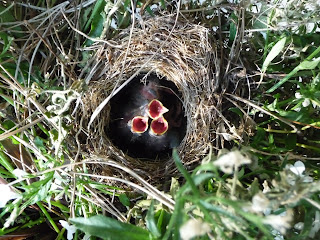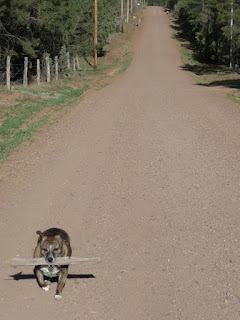For the first several years we owned our home, our back deck was the forgotten zone. Uninspiring, with no shade and painted a dark brown that soaked up the heat (with light baby blue trim--yuck!), it was a hot and basically miserable place to spend time. The "feel" of the deck matched the "feel" of the yard, which was nothing special either--dirt, some cinders, and three lilac bushes planted by the previous owner that never flower because we always have freezes well into May. Just for fun, here's a picture of what our yard looked like when we first moved here (I don't have a picture of the deck, it was that bad):
The best thing about it besides our previous dog Sheila standing out there was the one addition we first placed--a metal elk bird bath (which we still have and love). Being that the yard was the most uninspiring thing about our house, we spent the first four years of our lives here landscaping both the front and back yards. We first started with grass:
And added a small zig-zag of a fence for future flowering vines. And, as they say, after all this work, yadda yadda yadda, we now have this:
A pond is in front of the blue spruce tree; flowers that attract hummingbirds bloom all summer. Green grass prevents dogs tracking in mud. Blackberry and raspberry bushes hide in the back part of the yard. Bird and squirrel dramas play out on a daily basis--just this morning, a sharp-shinned hawk jetted in and tried to nab a pine siskin--and take a look at my entry from last year on our hummingbirds. We've seen squirrels stretched out on the grass, sleeping. We've attracted garter snakes to the pond, Arizona tree frogs to our gardens, and, unfortunately at times, skunks, raccoons, bears, and more to our oasis.
So a great yard finally deserved a decent back deck. A few years ago, we tore out the entire back deck, built a new, larger one, and covered part of it with a roof. It is like we opened up an entire new wing to the house--a liveable, breathable space where no TV is needed (or wanted) because all your entertainment is neatly packaged right in front of you, with nary a re-run. All you have to do is sit in a comfy chair with a drink of your choice, perhaps some knitting or a book, and you're set.
This snapshot of life from our back deck occurred between June and July 2012. First up, one day in mid-June we came home from work and took to watering our deck flowerpots. Lo and behold, hidden under a petunia was a nest with one little egg. Well, now, that was exciting. We moved the flower pot a couple feet to a better, safer location (on a plant stand under the eaves), got rid of the bird bath nailed to a corner of the deck (it attracts predatory birds like flickers and jays, who may find the nest), and started our daily security checks. A pair of dark-eyed juncos were the creators of what eventually became four eggs; they would fly back and forth to feed and incubate, soon becoming rather unafraid of us walking out onto the deck and every so often watering their flower pot to keep their cover alive.
Indeed, during the entire time, we'd often find one of the parents watching out over the nest from a nearby tree, a chair, the deck railing, and at times from our barbeque grill.
Life went on, however, for us. As the juncos were incubating their eggs, my friend Ellen arrived for a visit. Ellen, one of my dearest friends, happened to be the person who taught me how to knit. Whether or not that's a good thing--well, you may find differing opinions in our household after we basically remodeled our home so I could have a nook for my increasing stash of yarn. But that's neither here nor there. Suffice it to say that while I am an extremely happy person for a multitude of reasons (loving and beloved husband, incredible family and friends, great job, awesome dog, etc etc), my passion for knitting and any form of yarn-related crafts is a big part of that happiness. Ellen has picked up spinning, and makes her own fiber from all sorts of raw material, including alpaca, merino wool, silk, and cotton. Driving from Kansas to Arizona for a few weeks' vacation, Ellen was able to bring her spinning wheel with her to help me out with some very fine cashmere yarn--a gift from co-worker Nancy who happens to occasionally visit our Mongolia program and brought back an enormous amount of cashmere for me (thanks, Nancy!!!).
So during Ellen's visit, we would spend quite a bit of time on the back deck--starting out with coffee and breakfast, moving to knitting, spinning, reading, and crafting throughout the day, and ending with a glass of wine and some appetizers for happy hour(s).
Meanwhile, our view from the deck includes our garden. Things were starting to grow. Snap peas, lettuce, radishes, beets, basil, and soon after, zucchinis, were ready to pick.
And picked they were--nightly--and made into caprese salad, or sauteed with wild mushroom and sage-flavored olive oil, or eaten fresh, or, for my first time, made into pickled beets:
After Ellen left, a few days later our juncos hatched--three eggs out of four. It was amazing to watch their instinctual survival skills. While mom left the nest to find food, they huddled together and either slept or otherwise didn't move. The rustle of flowers indicated mom was returning, and they'd immediately strain their necks, heads facing upwards, mouths agape, waiting to be fed.
While the babies in the nest were growing, my husband's mother Anne and sister Amy arrived for a July 4th holiday visit. I think they spent more time on the back deck than I did--and it was rewarding to see them enjoy watching the birds and squirrels, read, or just lounge and relax. Amy's two dogs, Gracie and Holly, didn't miss a beat, finding that the deck chairs were more comfortable than the deck itself. It was Amy, too, who gave us the delightful Welcome (with the birds on top) centerpiece, a lovely addition to the deck:
Amy brought with her a great idea for a July 4th drink--layer frozen pina colada and strawberry daquiri mixes, and top with blueberries--yum! So the 4th was spent barbequeing elk burgers, drinking flag-inspired striped frozen concoctions, squirting each other with water rifles, and playing Yahtzee (Anne won!).
We maintained our vigilance over those baby juncos. Literature suggested they would fledge any time between 10 and 14 days. On Day 13, for some reason, I knew that was the day. The birds were ready--most of the time they were awake and alert. Tail and wing feathers looked strong (albeit still a bit on the stumpy side). Every once in awhile, one would jump to the edge of the nest, seemingly asking itself "am I ready?" and then answering "Nope, not yet" and hopping back to its siblings.
So we let the birds have a little privacy. We limited the dog activity and stayed inside (I was canning over 20 jars of zucchini relish, so it was good timing). Coincidentally, right around the time I was done canning and Bruce was taking a break from weeding, watering, or whatever he does "out there," we both were on the deck when the three juncos fledged. This video shows almost the entire thing--each bird hopping out of the nest and taking their first flight--all in a matter of about 4 minutes. The adults teased the birds to follow them into the bushes, and off they went. Amazing.
The back deck just didn't seem the same without those little birds. We re-arranged the flower pots and replaced the bird bath. We didn't have much time to wait, however, for our next bird adventure. It didn't have anything to do with OUR back deck--it started on our neighbor's back deck. He woke up to a young pre-fledgling Flammulated owl hopping around his deck--too young to fly, and no parents around. It stayed there most of the day, so he brought it over to our house (knowing we both were in the wildlife biz) in a box. A check by the local rehabilitator, Susan, was in order. She pronounced the bird healthy. We faced a difficult decision--the parents may or may not find the bird, but is it right to relegate a healthy bird to a life of captivity? We decided to replace the bird in a tree cavity that was close to the neighbor's deck, stocked it with mealworms and the bird itself, and played a tape of its call to let the parents know it was there. It's probably a good sign that we haven't seen it wandering around again.
So amongst the nesting juncos, barking tree frogs, pine siskins mobbing our feeders, tree squirrels chasing each other through the grass, hummingbirds finally showing up in large numbers, and zucchinis taking over the garden, we enjoy the hundreds of big and little dramas that occur every day on and around our back deck. Please come over sometime and join us. I promise you won't regret it!




















































